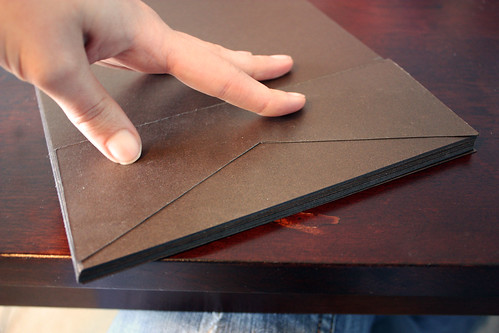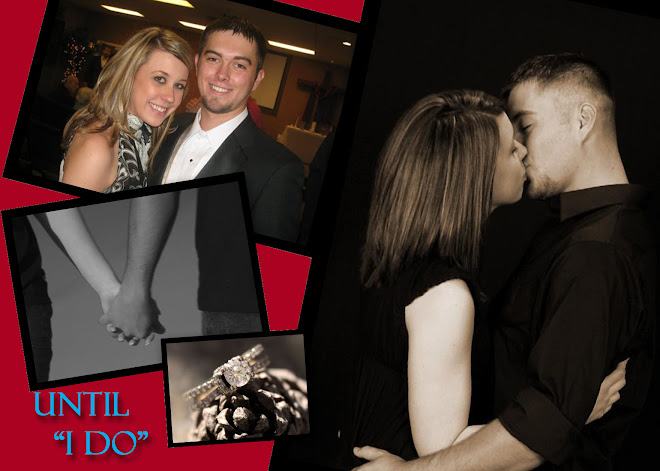I have been awarded a huge blessing recently in my life. Apart from finally working again (which is a blessing in and of itself), I am working at a store that definitely has slow moments. That and working part time hours allowed me to crank out the rest of those invites in record time. So now I can present to you: my pride and joy, the thorn in my side, my beautiful pocketfolds.

For anyone looking to take on this task, I will forewarn you: it is a lot of work and it is tedious. But once you find your rythm, it goes pretty quickly and it is so awesome to watch them come together before your eyes.
To start, this is what I used to create these babies:
- Cardstock, pre-cut to 16 1/8" x 7"
I ordered my cardstock pre-cut, so that all I had to do was fold, score and cut the flaps. - Paper cutter with a scoring blade (I bought mine at Joann Fabrics for $9.99 with a 40% off coupon)
- Bone Folder (to help make nice, neat creases)
- Scissors to cut the flap/pockets
- Pencil
- Double sided tape
I read lots of reviews on The Knot and decided to go with Super Tacky Tape in 1/8", which I ordered from Paper Source.
The Supplies:

Since I decided to be smart and make my life easier by having the cardstock precut (for no extra charge at the wonderful Anchor Paper) the process got started very quickly.
- The first thing I did was made score lines where my folds would be (I always went left to right with each step so I never got confused which side was which). You will need three score lines per invitation:
- The first score should be at 3 inches from one end of the cardstock. This score is for the flap of your invite.
- The next score is at 5 1/8 inches from the first score line. The section in between these first two score lines is where the main part of your invitation will be.
- The final score is 5 inches from the second score line. This creates the fold that will eventually become your pocket.
**Something I found that saved me SO much time, was rather than measuring and scoring one invitation at a time, the better thing to do was mark where the score lines needed to be on one invitation with a little hash mark on the edge with my pencil. Then, I just layered another sheet of cardstock on top of that and marked the same lines. I would do about 20 at a time like this and then score them. Its a little step, but it saved me a lot of time. **
After scoring them, I used a piece of scrap paper to make my templates for the pocket and the flap. I ended up going with a pointed flap and a pocket with a deep "V" shape.







- I used my flap/pocket templates to trace the shape onto my invite:

(Here I am placing my pocket template to trace it. )
MAKE SURE YOU TRACE IT SO THAT WHEN IT IS FOLDED UP THE POCKET GOES THE RIGHT WAY!

Tracing away.
- Once the flap and pocket templates were traced onto the invites, I used my scissors to carefully cut along those lines.

These are my invites, scored, cut and ready to be taped.
- Next, I applied my double sided tape to both sides of where my pocket would be. I learned the hard way that you do need to do it to both sides or the cardstock would not stay tightly bound.

FYI: I found this to be the most tedious step: applying the tape. It was hard to estimate how big each piece needed to be so I used my same pocket template and marked where the tape should end so I didn't have to guess. This eventually saved me lots of time and trying to peel off extra tape without ruining the cardstock. (Impossible and frustrating)
- Peel of the plastic backing of the tape

- Fold over the left side of the pocket and line it up.Press along the left edge to seal that side. Then, take your bone folder and crease along the bottom of the pocket to make a good fold. When you get to the right side, press down to seal that side too. Use your bone folder and press down along the edges where the tape is to make sure there is a good, tight seal.
**I have seen people fold and crease the pocket before applying the tape. I found this to be extremely annoying to do, because then the pocket wanted to flip up while you tried to put the tape on. Also, doing it this way (one side at a time) ensured that my pockets were straight.
- Use your bone folder to make the second crease where the next score line is:

- Make the final crease for the pointed flap.

TADA!
- Fold the whole thing over itself and there you have it. A complete (DIY) pocketfold!
Lessons Learned:I found that at first, this whole process took me about 10 minutes per invitation. That is because I was doing it in the dumbest way possible. AKA: each invite from start to finish, one at a time. Once I figured out that I could make it sort of an assembly line, it went so much faster and was so much more fulfilling. By creating my own shortcuts (marking where my score lines should be, taping before folding, etc.) I estimated that each invite took me about 2 minutes. I was able to finish 50 of them in an hour and a half. So, that is my recommendation for anyone who would like to take on this task. Take a stack of like 20 at a time to break up the monotony of certain steps (ahem, TAPE, ahem). Then, the condensed version of all this chatter becomes: mark your score lines, score, trace flaps and pockets, cut flaps and pockets, tape, adhere, fold, crease, tada! It really does become a routine and you will get faster. At the end of this very large undertaking, I can say I am so proud of myself for creating our invites from scratch. And so HAPPY because they are gorgeous! I cannot wait to get all the inserts designed so they can be fully assembled.












No comments:
Post a Comment